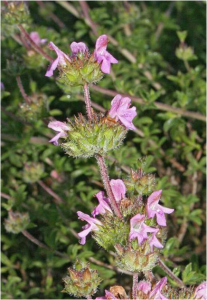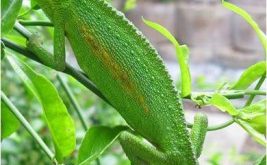Name: Thyme
Scientific name: Satureja thymbra
Description:
Standing, multi-branched, fragrant shrub, up to 1m high. Young shoots, hairy, glandular. Leaves simple, superficial, anthoid or elliptical, 7-18 x 2-7 mm, glandular, pointed. Flowers on vertebrae that form fine, elongated, staphylococcal inflorescences. Calyx 6 -8 mm, with almost equal, lanceolate teeth. Wreath, pomegranate purple, bipedal. Elongated hoses 1.8 x 0.8 mm.
Distribution:
Sardinia, Greece and Eastern Mediterranean countries from Turkey to Israel. It is found in various types of habitats such as Mediterranean shrubs, olive and carob forests and tracheal pine forests. In Cyprus, it was located at 4 locations on the north side of the Pentadaktilos between Akanthos and Flamoudi, and at a location in Pachyammos, Tilliria.
Habitat:
Forested places with Pinus brutia and Cupressus sempervirens and bushes with Cistus spp. and other low shrubs. Responds to sedimentary and refractory rocks. (altitude 180 – 300 m).
Biology:
Flowering: April – July. Fruiting: May – August. Contact with bees. It produces essential oils with a protective function. Its essential oils act as a rain detector, as they inhibit germination until they are washed away by the rain.
Conservation status and threats:
The population includes about 2000 plants. The vast majority of plants are limited to one place, while the other 4 places have from 8 to 25 people each. It is threatened by fires, construction and improvement of roads and deforestation for agricultural purposes.
Value and Uses:
Aromatic and flavouring and suitable for rock gardens. The young shoots are used as a seasoning in various dishes such as meat, fish, omelettes, soups and sauces. The essential oil is used in perfumery, for the aromatization of liqueurs and bread.
Sources:
[1] Το κόκκινο βιβλίο της Χλωρίδας της Κύπρου. Φιλοδασικός σύνδεσμος Κύπρου, 2007.
[2] Χατζηκυριάκου., Γ. (2007). Αρωματικά και Αρτυματικά φυτά στην Κύπρο

 Κυπριακό Κέντρο Περιβαλλοντικής Έρευνας & Εκπαίδευσης – Κυκπεε
Κυπριακό Κέντρο Περιβαλλοντικής Έρευνας & Εκπαίδευσης – Κυκπεε




